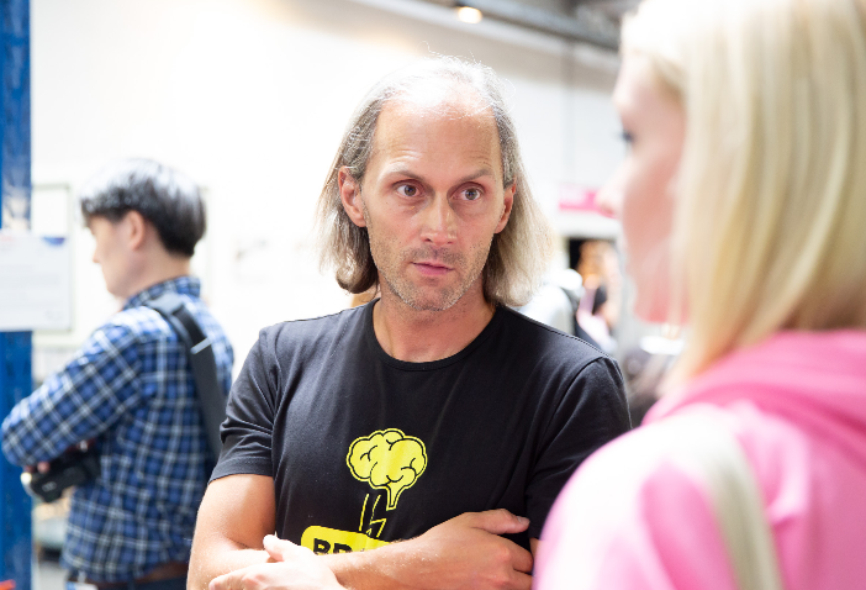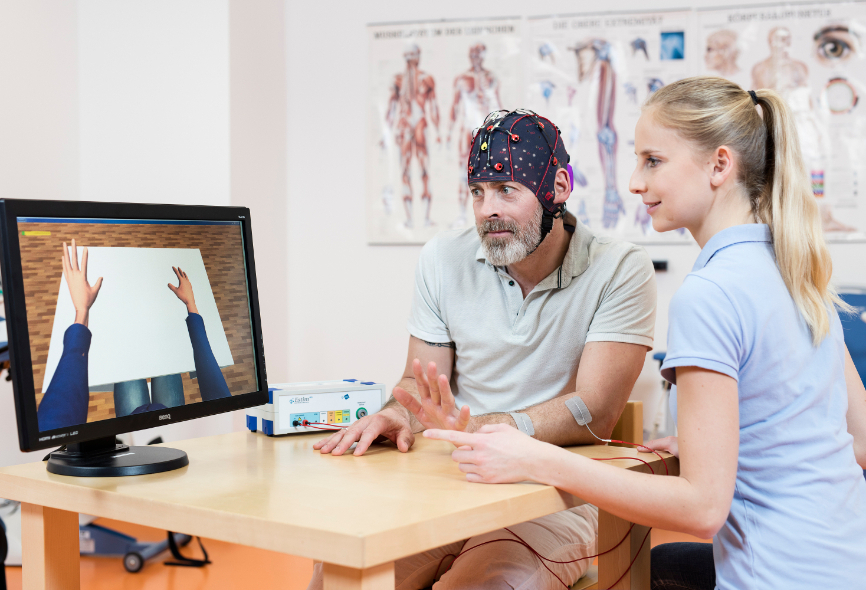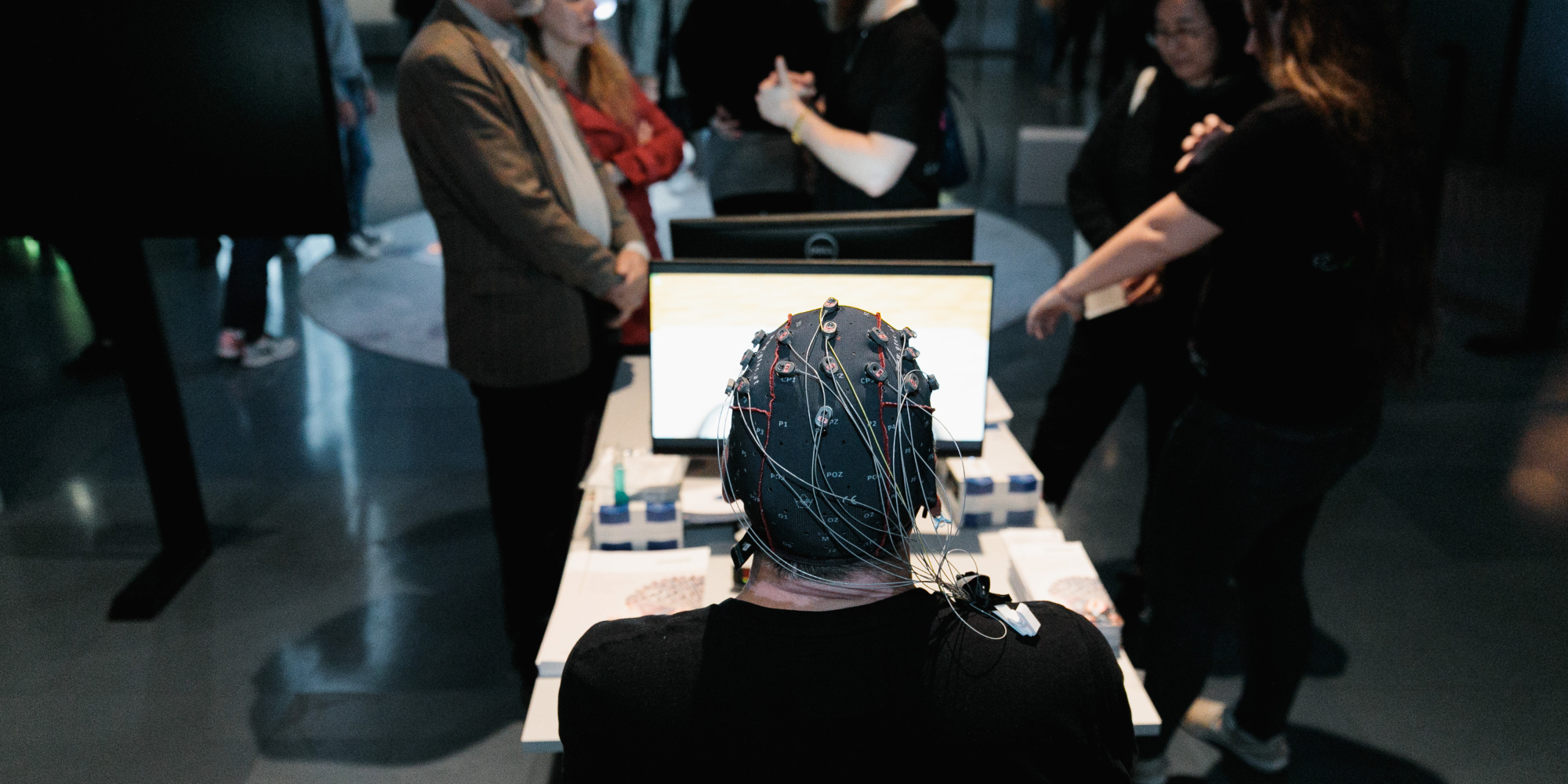Ars Electronica and the biomedical engineering company g.tec, based in Schiedlberg near Linz, have already been cooperating on different levels for several years. Brain Computer Interface (BCI) Designer Hackathons are held at the festival, where developers, artists and programmers meet to implement creative new projects 24 hours in a row using technology at the interface between brain and machine. In 2018, g.tec was significantly involved in the fire brigade challenge: The Rosenbauer Concept Truck, an emergency vehicle of the future, had to be controlled via BCI in order to change the lighting of the truck. In 2017, the Schiedlberger technology company was represented on the Postcity site with an excavator that could be controlled purely by thought power. While we eagerly await what the g.tec developers have come up with for this year’s festival, two brand-new medical products have been on display at the Ars Electronica Center since May 27: recoveriX and mindBEAGLE. G.tec managing director and founder Christoph Guger talked to us about the possibilities for stroke and coma patients.
With your items in the new exhibition, what can visitors experience, what can you see and experience?
Christoph Guger: One station is recoveriX, the system for stroke regeneration. You can go down there, then an EEG hood is put on, with eight sensors that measure the brain waves and extract this information. The BCI will then instruct you via an avatar that you should imagine a left or right hand movement, just think of it. Then the BCI recognizes that you are imagining this movement and we trigger a muscle stimulator. We send a small electrical impulse into the muscle so that the right or left hand really moves. This leads to pairing of these cognitive processes with motor movements. In this way, the patient learns to move the hand again.
At the second station – mindBEAGLE – this is the ward for coma patients, you can also put on this EEG hood, the brain waves are also extracted, then there are various experiments that can be carried out. One of them deals with auditory stimuli. Headphones are used to play high and low tones and you have to count the high tones afterwards. This leads to a reaction in the brain that the BCI can recognise. If you find these reactions, you know that the patient is able to recognize and count high tones. If these reactions are not found, either the patient is asleep or his brain is unable to distinguish between high and low tones. In a further step, the test person can be given yes/no questions, which he answers mentally. In coma patients this is the decisive step in whether they can say yes/no or find no answer. This is very impressive when a patient lies in a vegetative state for years and you have no information as to whether he or she is aware of something. If the magnifying glass suddenly moves to Yes or No, you know that he actually notices everything.
The museum also has 16 end users, BCIs, called Unicorns. They are very easy to use and with them you can quickly learn to measure EEG data and BCI data correctly. Ars Electronica plans to hold workshops where 16 or 32 students, programmers, developers, artists will come and test this BCI technology and create their own applications for a day or even a whole week. If someone works with music, they can attach the BCI to an audio machine to compose music. If someone likes to paint, they can use the drawing program to paint pictures. Or he can come with his own drone, connect it to the BCI and fly with it.

What do you think about the fact that the new exhibition deals with different topics in one place? How can the different themes complement and optimise each other?
Christoph Guger: The fact that many different people visit the museum means that you get in touch with our technologies and can try out the recoveriX and mindBEAGLE systems here. We also want to get patients who have had a stroke or people who know a patient in a vegetative state. They can come here, try out the system to see if it is theoretically useful for them, and later they can take advantage of this therapy, this brain assessment. Therapists also have the opportunity to try out this therapy. Of course, many visitors whose acquaintance or relatives had a stroke also come here. This spreads the information.
How could BCI and AI (artificial intelligence), if they stand next to each other in the exhibition, complement or advance each other?
Christoph Guger: Our brain interface uses AI algorithms, which are basically different machine learning algorithms that are needed for signal analysis because otherwise nothing can be extracted from the brain waves. And these algorithms can of course be used for very different applications. We extract information from the brain, but these algorithms can also be used to generate information from spring sensors, or climate change sensors use the same algorithms. So it’s all connected in the museum. It’s the same signal processing principle that all of them use.
You mentioned it before, but your product is more of a service than a product, right?
Christoph Guger: We are selling the system but with a guide on how to use it properly for therapy or brain assessment. So the doctors and therapists have to come to us for training, they have to learn it, they have to treat patients and then they can use it in hospitals or in therapy facilities, rehabilitation centres. They have to buy this system and then offer the service. What we also do as a company is that we have opened recoveriX gyms. People, patients, can come to us and receive the therapy in different places – from Linz to Barcelona.

In the field of patient therapy, there are numerous innovations in how to address and activate them. Where do you think the path leads, how much more potential do you see in this area?
Christoph Guger: There are still many unknown things. You have to imagine that if you have had a stroke, you will spend 8 to 10 days in an acute hospital. There you get medication and are stabilised. Then you are discharged, go to a rehabilitation centre and after about two months the whole treatment and therapy is over. Then you may be able to visit a physiotherapist or occupational therapist a few times, but that’s it. From then on you are on your own. This is exactly the gap we fill with recoveriX. You can still do a lot for your body after you have been released from the standard health system and we know that these patients have better movements, less cramps, less tremor, memory functions become better again, which means they can concentrate better and remember things… it has many positive effects. We close this gap with this neurotechnology, because otherwise these chronic patients have no chance to improve. It is similar in coma patients. For example, they had a car accident that led to brain damage. They come to the hospital, are stabilised there and then a brain assessment is carried out. This involves examining whether he can do something, whether he can move something or whether he understands something. This is done once, then no more. The patients are discharged, but we know that the status can change. Patients with a coma vigil have large fluctuations, one day they can’t do anything, just drift away, the next day they are good and understand everything. But you don’t know it and through our system you are able to raise exactly this. How they are today. Then one speaks more with the coma patient and if he has no awareness, simply drifts away, one invests less time on this day. Without this neurotechnology you would be blind, you wouldn’t know.

Christoph Guger is the founder and managing director of g.tec medical engineering GmbH. He studied Bio-/Medical Engineering at the Graz University of Technology and the Johns Hopkins University in Baltimore, USA, where he developed the first Brain-Computer Interface, which records and processes brain signals in real time. The company started manufacturing medical products a few years ago. Two of these, recoveriX and mindBEAGLE, have been on display at the Ars Electronica Center since May 27 and can also be tested there. RecoveriX is used for the rehabilitation of stroke patients. With the help of mindBEAGLE it is possible to determine whether coma patients are able to understand a conversation.
